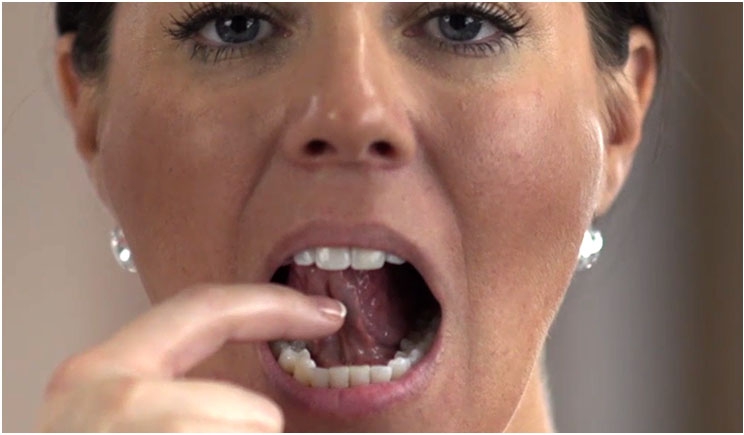
The number of oral cancer cases and deaths in the United States is concerning. The American Cancer Society estimates that 54,010 people will get oral cancer in 2021, and 10,850 of those people will die. How can we, as dentists—explorers of the chops, preservers of the nutritional portal—step in and stomp this number down? We screen our patients, of course, and we also begin teaching our patients how to screen themselves.
We have the tendency, with our gloved hands and masked face, to sit up straight and gently massage our way through a silent exam to which we (hopefully) proclaim at the end, “Oral cancer screen is negative.” While this is a relief to our patients, they have no idea how we have come to such a conclusion and develop no familiarity with the signs and symptoms to be aware of, blindly relying on our keen, louped eyes every six to 12 months.
According to current Centers for Disease Control and Prevention stats, only 64.9% of adults aged 18 and over visited the dentist in 2019, with the percentage in 2020 presumably much less (thanks, COVID-19). This means there are a lot of people who are not being screened regularly. For this reason, guiding our patients through their oral cancer exams may just be the element of patient empowerment that reduces oral cancer cases and related deaths once and for all.
The earlier oral cancer is caught, the greater the chance of survival. That’s why many cancer prevention resources recommend monthly self-examination. This means it isn’t enough for us, as providers, to be the only ones checking for oral cancer once or twice a year.
It’s time to talk patients through the steps of our screening in a repeatable, memorable, and meaningful way as we encourage them to screen themselves monthly. If this means singing the steps, let’s go for it. If this means devising our own acronym, we should feel free. Whatever it takes to move from the silent superhero to the audible and impactful one, let’s do that!
The Extraoral Exam
Generally, a good and thorough oral cancer screening starts with the extraoral examination and moves intraorally. As we begin, explain that it’s important to evaluate the head, neck, mouth, and tongue because oral cancer is most often found in the tongue, tonsils, oropharynx, gums, and other parts of the mouth.
As we are visibly evaluating the skin of the head, neck, and lips, we can explain to the patient that we are looking for any concerning asymmetries, discolorations, or masses. It’s beneficial to have the patient open wide and observe for any painful popping of the jaw.
Next, we can move into gentle palpation of the parotid glands, pre-auricular and posterior auricular lymph chains, and on to the underside of the jaw (submandibular glands and submental). We can explain to the patient that we are feeling for tender nodes or painless lumps.
From there we can gently palpate along the lymph chain of the sternocleidomastoid muscle as the patient turns their head in either direction. Observing the thyroid with gentle palpation as the patient swallows is a great way to check for any concerning nodules. At this point, it is highly likely that the patient is grateful for such a thorough exam in the hands of someone who really knows their stuff!
The Intraoral Exam
Next, look at the inside of the lips and evaluate all gingival tissues, the depths of the vestibules, sides of the tongue, floor of the mouth, roof of the mouth, and tonsillar pillars. Again, an exam like this becomes a whole lot more meaningful (and we as clinicians become a whole lot more credible) when we are calling out the names of each anatomical landmark as we examine them, expressing to the patient exactly what we are looking for and what we are seeing along the way.
We want the patient to know that we are feeling for masses as we are gently squeezing the tissues of the inner and outer buccal mucosa and lips between our fingers and exploring the floor of the mouth. We want our patients to know that we are examining for ulcerations or discolorations, and unusual textures or growths, as we are evaluating the vestibules and intraoral tissues.
Checking the tongue can be a little awkward for a patient, especially if they’ve never experienced such a thorough exam. It can be a great icebreaker and good for a giggle to warn the patient that we must now briefly “wrangle the tongue for a good looksee.”
At the end of an exam of this caliber, the patient is likely feeling relaxed and quite impressed with the level of care they have received and even more trusting of your ability to see them through their dental needs. Most importantly, the patient was exposed to every step in a thorough clinical investigation for oral cancer. That’s a win all the way around!
The patient is empowered with the understanding of exactly what we are looking for and where, and they will take that new knowledge home with them. We should encourage our patients to do their best at examining these landmarks once a month on their own and call us with any concerning areas that have not healed within two weeks as well as any new findings.
An informed patient is an empowered one, and instructing patients through a thorough screening process is one way we can create the awareness necessary to take down oral cancer once and for all.
Dr. Schneider is the dental director at Delta Dental of Arizona and has more than 19 years of experience in dental administration, dental education, and clinical dentistry.
Related Articles
Celebrate Oral Cancer Awareness Month This April
Research to Reprogram White Blood Cells to Fight Oral Cancer
Hydrogel Improves Oral Cancer Immunotherapy











